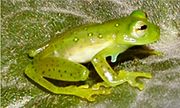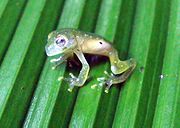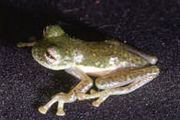Glass frog
| Glass Frogs | ||||||||||||
|---|---|---|---|---|---|---|---|---|---|---|---|---|
 Hyalinobatrachium ruedai
|
||||||||||||
| Scientific classification | ||||||||||||
|
||||||||||||
Distribution of Centrolenidae (in black)
|
||||||||||||
| Genera | ||||||||||||
|
Centrolene |
Glass frog (or Glassfrogs) is the common/popular name for the frogs of the amphibian family Centrolenidae (order Anura). While the general background coloration of most glass frogs is primarily lime green, the abdominal skin of some members of this family is transparent. The internal viscera, including the heart, liver, and digestive tract are visible through this translucent skin, hence the common name.
Contents |
Historical Account of Taxonomy
The first described species of Centrolenidae was the "giant" Centrolene geckoideum, named by Marcos Jiménez de la Espada in 1872, based on a specimen collected in northeastern Ecuador. Several species were described in subsequent years by different herpetologists (including G. A. Boulenger, G. K. Noble, and E. H. Taylor) but usually placed together with the treefrogs in the genera Hylella or Hyla.
The family Centrolenidae was proposed by Edward H. Taylor in 1951. Between the '50s and '70s, most species of Glassfrogs were known from Central America, particularly from Costa Rica and Panama, where E. H. Taylor and Jay M. Savage extensively worked, and just a few species were know to occur in South America. In 1973, John D. Lynch and William E. Duellman, published a large revision of the glass frogs from Ecuador showing that the species richness of Centrolenidae was particularly concentrated in the Andes. Later contributions by authors like Juan Rivero, Jay Savage, William Duellman, John D. Lynch, Pedro Ruiz-Carranza and José Ayarzagüena increased the number of described taxa especially from Central America, Venezuela, Colombia, Ecuador, and Peru.
The evolutionary relationships, biogeography, and character evolution of centrolenids was discussed by Guayasamin et al. (2008[1]). Glass frogs originated in South America and dispersed multiple times into Central America. Character evolution seems to be complex, with multiple gains and/or losses of humeral spines, reduced hand webbing, and complete ventral transparency.
The taxonomical classification of the glass frogs is problematic. Although four genera had been described for Centrolenidae (Centrolene, Centrolenella, Cochranella, Teratohyla), the taxonomical arrangements were always incomplete, and not valid for all species. In 1991, after a major revision of the species and taxonomic characters, the herpetologists Pedro Ruiz-Carranza and John D. Lynch published a new proposal for a taxonomic classification of the Centrolenidae based on cladistic principles and defining monophyletic groups [2]. That paper was the first of a series of contributions dealing with the glass frogs from Colombia that lead them to described almost 50 species of glass frogs. The genus Centrolene was proposed to include the species with a humeral spine in adult males, and the genus Hyalinobatrachium to include the species with a bulbous liver[2]. However, there was an heterogeneous group of species that they left in the genus Cochranella, defined just by lacking a humeral spine and a bulbous liver[2]. Since the publication of the extensive revision of the Colombian glass frogs, several other publications have dealt with the glass frogs from Venezuela, Costa Rica, and Ecuador.
Recent molecular studies [3] have found that the three genera of Glass frogs are non-monophyletic units, although taxon sampling was limited. The genus Centrolene is paraphyletic towards the genus Cochranella, and some species of Hyalinobatrachium were apparently more related to Cochranella.
Furthermore, they included the genus Allophryne in the family Centrolenidae, dividing the family into two subfamilies: (1) the subfamily Allophryninae for the genus Allophryne, and (2) the subfamily Centroleninae for the genera Centrolene, Cochranella, and Hyalinobatrachium. A reanalysis of morphological traits suggested a polyphyletic Centrolene and Cochranella, and supported the monophyly of the Hyalinobatrachium fleischmanni group [4]
Other studies have addressed the same problem; e.g., in 2006 a scientific paper describing a new species of Centrolene from Ecuador [5] removed the species "pulveratum" and "antisthenesi" from Hyalinobatrachium and placed them inside the genus Cochranella as Cochranella pulverata and Cochranella antisthenesi. Although these changes kept Cochranella paraphyletic, they "clean" Hyalinobatrachium in order to define a monophyletic group. A recent review of the family [6] has recognized a new genus, Nymphargus, for the species with basal webbing among outer fingers (part of the previous ocellata species group). A novel hypothesis of relationships based on nuclear and mitochondrial genes suggests that all recognized genera are para- or polyphyletic (Guayasamin et al., 2008[7]).
Classification
The family Centrolenidae is a clade of anurans. Previously, the family Centrolenidae was considered closely related to the family Hylidae; however, recent phylogenetic studies[3] have placed the Centrolenidae (and its sister taxon, the family Allophrynidae, closer to the family Leptodactylidae.
The monophyly of Centrolenidae (excluding Allophryne) is supported by morphological and behavioral characters including[3] [5]: (1) presence of a dilated process on the medial side of the third metacarpal (an apparently unique synapomorphy); (2) ventral origin of the musculus flexor teres digiti III relative to the musculus transversi metacarpi I; (3) terminal phalanges T-shaped; (4) exotroph, lotic, burrower/fossorial tadpoles with a vermiform body and dorsal C-shaped eyes, that live buried within leaf packs in still or flowing water systems; (5) eggs clutches deposited outside of water on vegetation or rocks above still or flowing water systems. Several molecular synapomorphies also support the monophyly of the clade [3].
The taxonomic classification of Centrolenidae is still controversial, but currently four genera of Glassfrogs are recognized: Centrolene, Cochranella, Hyalinobatrachium, and Nymphargus. A recent molecular phylogeny (Guayasamin et al. 2008) suggests that these genera are para- or polyphyletic.
Genera



Family CENTROLENIDAE
- Subfamily Allophryninae
- Genus Allophryne - Tukeit Hill Frogs (Gaige, 1926)
- Subfamily Centroleninae
- Genus Centrolene - Giant Glass Frogs (Jiménez de la Espada, 1872)
- Genus Cochranella - Cochran Frogs (Taylor, 1951)
- Genus Hyalinobatrachium - "True" Glass Frogs (Ruiz-Carranza & Lynch, 1991)
- Genus Nymphargus (Cisneros-Heredia & McDiarmid, 2007)
Characteristics
Glass frogs are generally small, ranging from 3 centimetres (1.2 in) to 7.5 centimetres (3.0 in) in length. They are green in color over most of their bodies, save for the skin along the lower surface of the body, which is translucent.[8]
Glass frogs are similar in appearance to some green frogs of the genus Eleutherodactylus and to some Treefrogs of the family Hylidae. However, hylid treefrogs have eyes that face to the side, whilst those of glass frogs forward facing eyes. Some species of green tree frogs (especially juveniles), such as Hyloscirtus palmeri and Hypsiboas pellucens, have the transparent abdominal skin typical of glass frogs, but they also have calcars on the heels, a character not present in any species of the family Centrolenidae.
Distribution
Centrolenidae is a diverse clade of frogs distributed from southern Mexico to Panama, and through the Andes from Venezuela to Bolivia, with some species in the Amazon and Orinoco River basins, the Guiana Shield region, southeastern Brazil, and northern Argentina.
Biology
Glass frogs are mostly arboreal. They live along rivers and streams during the breeding season, and are particularly diverse in montane cloud forests of South America, although some species occur also in Amazonian and Chocoan rainforest and semi-deciduous forests.
The eggs are usually deposited on the leaves of trees or shrubs hanging over the running water of mountain streams, creeks, and small rivers, or over stones close to waterfalls. The method of egg-laying on the leaf varies between species. The males usually call from leaves close to their egg clutches. The eggs are less vulnerable to predators than those laid within water, but are affected by the parasitic maggots of some fly species[8]. As a result, some glass frogs show parental care. After they hatch, the tadpoles fall into the waters below. The tadpoles are elongate, with powerful tails and low fins, suited for fast flowing water[8]. Outside of the breeding season some species live in the canopy.
References
- ↑ Guayasamin, J. M., S. Castroviejo-Fisher, J. Ayarzaguena, L. Trueb y C. Vilá. 2008. Phylogenetic relationships of glass frogs (Centrolenidae) based on mitochondrial and nuclar genes. Molecular Phylogenetics and Evolution 48:574–595.
- ↑ 2.0 2.1 2.2 Ruíz-Carranza, P.M. and J. D. Lynch. 1991. Ranas Centrolenidae de Colombia I: propuesta de una nueva clasificación genérica. Lozania, 57, 1–30.
- ↑ 3.0 3.1 3.2 3.3 Frost D.R., Grant, T., Faivovich, J., Bain, R.H., Haas, A., Haddad, C.F.B., de Sa, R.O., Channing, A., Wilkinson, M., Donnellan, S.C., Raxworthy, C.J., Campbell, J.A., Blotto, B.L., Moler, P., Drewes, R.C., Nussbaum, R.A., Lynch, J.D., Green, D.M. & Wheeler, W.C. (2006) The Amphibian Tree of Life. Bulletin of the American Museum of Natural History, 297, 1–370. (PDF available by clicking here)
- ↑ Guayasamin, J. M., M. R. Bustamante, D. Almeida-Reinoso, and W. C. Funk. 2006. Glass frogs (Centrolenidae) of Yanayacu Biological Station, Ecuador, with the description of a new species and comments on centrolenid systematics. Zoological Journal of the Linnean Society 147:489–513.
- ↑ 5.0 5.1 Cisneros-Heredia, D.F. & McDiarmid, R.W. (2006). A new species of the genus Centrolene (Amphibia: Anura: Centrolenidae) from Ecuador with comments on the taxonomy and biogeography of Glassfrogs. Zootaxa 1244: 1-32 - Description of Centrolene mariaelenae. (PDF of the abstract available by clicking here)
- ↑ Cisneros-Heredia, D.F. and R.W. McDiarmid. 2007. Revision of the characters of Centrolenidae (Amphibia: Anura: Athesphatanura), with comments on its taxonomy and the description of new taxa of glassfrogs. Zootaxa 1572: 1-82. PDF Available by clicking here
- ↑ Guayasamin, J. M., S. Castroviejo-Fisher, J. Ayarzaguena, L. Trueb y C. Vilá. 2008. Phylogenetic relationships of glassfrogs (Centrolenidae) based on mitochondrial and nuclar genes. Molecular Phylogenetics and Evolution 48:574–595.
- ↑ 8.0 8.1 8.2 Zweifel, Robert G. (1998). Cogger, H.G. & Zweifel, R.G.. ed.. Encyclopedia of Reptiles and Amphibians. San Diego: Academic Press. pp. 94-95. ISBN 0-12-178560-2.
External links
- Amphibian Species of the World
- Centrolenidae in AmphibiaWeb Ecuador [1]
- Centrolenidae in AmphibiaWeb
- Glassfrogs (Centrolenidae) Project
- Centrolenidae in the Tree of Life site
- Centrolenidae in ITIS
- Research on Centrolenidae
- Centrolenidae in Livingunderworld.org
- Centrolenidae in Animal Diversity Web
- Centrolenidae en InfoNatura
- Fleischmann’s glass frog at National Geographic
- Various Frog Species
|
|||||||||||||||||